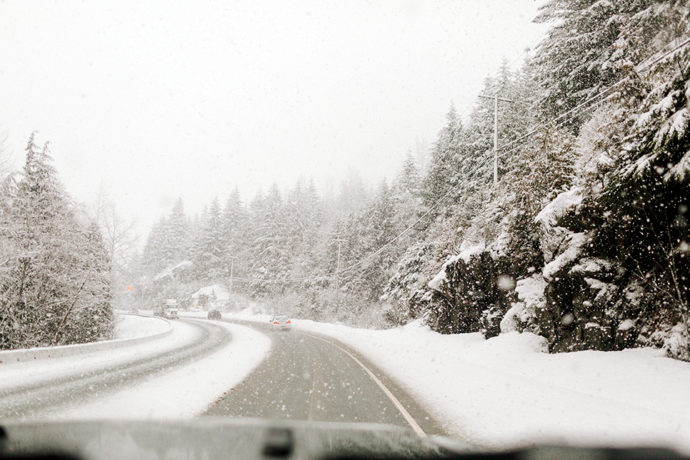If you’re a driver in a mountainous region, you’re no stranger to winding roads and high-altitude locations. But have you ever considered how those high altitudes affect your vehicle’s performance, fuel economy, and even its auto glass?
In this article, we’ll explore the impacts of driving at high altitudes and provide practical tips to help you navigate the challenges of mountain driving.
Does High Altitude Affect a Vehicle?
Yes. Here’s why: At higher altitudes, the air density decreases, meaning there is less oxygen in the air. This can significantly impact your vehicle’s internal combustion engine, which relies on a delicate balance of fuel and oxygen to function properly. With less oxygen available, your vehicle engine performance suffers, leading to decreased engine performance.
According to the rule of thumb, engine performance drops by about 3% for most cars for every 1,000 feet of elevation gain. So, if you’re driving in the mountains at elevations of 10,000 feet or more, your car’s engine could produce up to 30% less power than it would at sea level. This power loss can be especially noticeable when accelerating or climbing steep grades.
Does High Altitude Affect Gas Mileage?
Yes, driving at higher altitudes can affect your vehicle’s fuel efficiency. With less air and less oxygen available, your engine may require more fuel to maintain the proper air-fuel ratio. This can lead to reduced gas mileage, especially if you’re driving an older vehicle or one with a carburetor instead of fuel injectors.
To combat the effects of altitude on fuel efficiency, some gas stations in mountain areas offer high-octane fuel. Higher octane ratings indicate a fuel’s resistance to pre-ignition or “knocking,” which can occur more easily at higher elevations due to the lower air density. Using a higher octane fuel can help maintain the vehicle engine performance and fuel efficiency at high altitudes.
However, it’s important to consult your vehicle’s owner’s manual before switching to a higher-octane rating. Some vehicles are designed to run on lower-octane fuel and may not benefit from or even be compatible with higher-octane options. In these cases, using a higher octane version of fuel could be a waste of money as gas mileage could remain the same, as if you were using low octane fuel and even cause more wear to your engine.
Tire Pressure and High Altitude Driving
Another important consideration when driving at high altitudes is tire pressure. As you gain elevation, the pressure in your tires decreases, just like the air density around your vehicle. This can lead to underinflated tires, which can reduce fuel economy, cause uneven tire wear, and even increase the risk of a blowout.
To prevent these issues, it’s important to check your tire pressures regularly when driving in the mountains. Many newer vehicles come equipped with tire pressure monitoring systems that can alert you to low tire pressure, but it’s still a good idea to manually check your tires before embarking on a high-altitude drive.
When adding air to your tires at high elevations, be sure to fill them to the recommended pressure listed in your vehicle’s instruction manual or on the tire information placard located in the driver’s side door jamb. Don’t overinflate your tires to compensate for the lower air density, as this can lead to a harsh ride and increased wear on the center of the tire tread.
High Altitude and Auto Glass
While the effects of altitude on engine performance and tire pressure are well-known, many drivers may not consider how mountain driving can impact their vehicle’s auto glass. The changes in pressure and temperature associated with high-altitude driving can indeed take a toll on your windshield and other auto glass components.
As you drive up into the mountains, the air pressure outside your vehicle decreases, while the pressure inside your vehicle remains relatively constant. This pressure difference can put stress on your windshield, especially if it already has a small chip or crack. In some cases, the change in pressure can cause a small chip to quickly spread into a large crack, necessitating a windshield replacement.
Temperature changes can also affect your auto glass at higher altitudes. As you gain elevation, the temperature often drops, and your vehicle’s glass may contract slightly. When you descend to lower altitudes, the glass expands again. Over time, these repeated temperature changes can weaken your auto glass, making it more susceptible to damage from road debris or other impacts.
To protect your auto glass when driving at higher altitudes, it’s important to address any chips or cracks as soon as possible. A professional auto glass repair or replacement can help prevent further damage and ensure your safety on mountain roads.
Preparing Your Vehicle for High-Altitude Driving
Before heading out on a mountain road trip, it’s a good idea to have your vehicle inspected by a trusted mechanic. They can check your engine, fuel system, tire pressure, and auto glass to ensure everything is in good working order.
If you’re planning to visit extreme altitudes (above 10,000 feet), consider having your vehicle’s engine tuned specifically for high-altitude performance.
It’s also a good idea to carry a tire pressure gauge and a portable air compressor or tire inflator in your vehicle when driving in the mountains. This way, you can easily check and adjust your tire pressure as needed, even if you’re far from a gas station.
How Driving at High Altitudes Can Affect a Driver
In addition to the effects on your vehicle, high-altitude driving can also impact your personal performance and comfort. The lower oxygen levels at higher elevations can lead to fatigue, headaches, dizziness, and even altitude sickness in some cases.
To minimize these risks, stay hydrated, take breaks as needed, and avoid alcohol consumption before or during high-altitude drives.
It’s also important to be aware of the potential for rapidly changing weather conditions in the mountains. A sunny day can quickly turn into a snowstorm at higher elevations, so be prepared with appropriate clothing, snow tires, and chains if necessary.
Of course, when driving at higher altitudes, it’s important to maintain a safe speed and use extra caution on steep grades and winding roads. The reduced engine power and potential for icy conditions can make it more challenging to control your vehicle, so take it slow and leave plenty of space between you and other vehicles.
Finally, be sure to pack an emergency kit with essentials like water, snacks, a flashlight, and a first-aid kit. While altitude sickness is more common among hikers and skiers, it can also affect drivers who ascend to high altitudes quickly. If you experience symptoms such as headaches, dizziness, or nausea while driving, safely pull over and take a break until you feel better.
Keeping Your Vehicle Mountain Ready
Driving at higher altitudes presents unique challenges for both you and your vehicle. By understanding how the thinner air affects your engine performance, fuel efficiency, tire pressure, and auto glass, you can take steps to prepare your vehicle and yourself for safe mountain driving.
Remember to have your vehicle inspected regularly, use the appropriate fuel, monitor your tire pressure, and address any auto glass damage promptly. With a little extra care and attention, you can confidently navigate beautiful mountain roads while minimizing the impact of the higher altitude on your vehicle.



